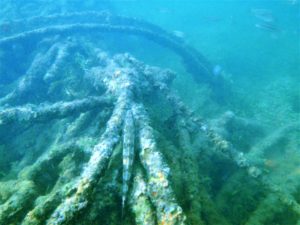This fish that I photographed at the Ships’ Graveyard in the North Arm of the Port River earlier this year was confirmed on iNaturalist as being a Congolli (Pseudaphritis urvillii).
I had reported the sighting of the Congolli in my article titled Further Discoveries at the Ships Graveyard.
I came across another one in Angas Inlet at the Garden Island jetty during a night dive there on 8th June (World Oceans Day). My photos of it were certainly not very sharp but they were confirmed as being a Congolli (Pseudaphritis urvillii) on iNaturalist again.
There didn’t seem to be much about Congolli in the numerous fish books that I have. Apart from the old “The Marine and Freshwater Fishes of South Australia” by Scott, Glover & Southcott, the only other ‘fish’ book that I could quickly find Congolli in was the revised edition of “Australian Marine Life” by Graham Edgar.
That book, however, showed the scientific name for Congolli as Pseudophritis urvillii (with an ‘o’ instead of an ‘a’ in Pseudaphritis). I was quick to protest to iNaturalist that they were incorrectly spelling Pseudophritis as Pseudaphritis, but they soon put me wise. It was actually incorrect in “Australian Marine Life” and Pseudaphritis was correct (as confirmed in “The Marine and Freshwater Fishes of South Australia”. I soon corrected the Society’s copy of “Australian Marine Life” by changing the ‘o’ to an ‘a’.
There didn’t seem to be much interest in Congolli in the various other fish books that I had, but I hadn’t thought to look in our Society’s copy of “Wildlife of Greater Adelaide” by James I.D. Smith. I later found it there on page 247.
I’ve recently been saying how the scientific names of species are often changing. In my article entitled Nudibranch name change I said, “According to this web page, “two-part scientific names contain a hierarchy which can change if an organism is re-classified”.
I wrote about this topic in my article entitled Changes to Seastar Names:
“It can be difficult for ‘hobbyists’ such as ourselves to keep up with the changes for projects such as our Photo Index. It recently came to my attention, thanks to Society member Jeff Bowey, that the red-netted nudibranch previously known as Chromodoris tinctoria is now known as Goniobranchus tinctorius.”
A further change that I haven’t yet mentioned is the change of scientific name for Western King Prawn. It has changed from Penaeus latisulcatus to Melicertus latisulcatus. I have been trying to update all of my reference books accordingly. (I also saw some Western King Prawns during my night dive at Garden island.)
Western King Prawn
Then there are regular changes in the classification of species. Both “The Marine and Freshwater Fishes of South Australia” and “Australian Marine Life” show Congolli as being part of Bovichthyidae, the Thornfish family. This meant that they were in the same group as dragonets/thornfish. But as I had indicated in my article Further Discoveries At The Ships Graveyard, according to iNaturalist, “Pseudaphritis urvillii is the only species of fish in the family Pseudaphritidae and the genus Pseudaphritis”. So Congolli now stands alone in a group of its own.
In my article Shovelnose Stingarees I wrote “Fish identification can be tricky at the best of times. Then there are often new species that were not included in the old fish books. And the scientific names of species are often changing, and even changing back again.” and “The Western Shovelnose Stingaree had been described by Whitley in 1939. It is listed as Urolophus mucosus in “Sea Fishes of Southern Australia” by Barry Hutchins and Roger Swainston under the common name of just “Western Stingaree”. The scientific name has now changed to Trygonoptera mucosa and ‘Shovelnose’ has been added to the middle of the common name.”





Dave Muirhead says that Congolli are estuary and fresh water native fish. He says that they were a favourite food of many coastal aboriginals before white settlement. He says that they are now much less common for the same basic reasons so many native freshwater fish here in SA are in decline.
He goes on to say, “This species is monotype in its genus i.e. making it even more unique to the creeks and rivers of southern Australia.
Not long ago (on a hot calm day early in the warm season i.e. Spring last year, I found many dead ones in warm tide pools only a few 100 metres north east of little Gorge Creek Beach. The most likely cause of death was the mix of heavy rain, poor catchment care, outflows suddenly of filthy fresh water onto the shallow intertidal reef platform at Lady Bay. They were hypoxic and heat stress finished them off. The main outflow was Yankalilla River via Big Gorge another few 100 metres north east of the shacks site but the Little Gorge Creek outflows added their bit.”
Faith Coleman says, “Congolli are the species of fish used to justify environmental flows for the Gawler River. It took various stakeholders and NRM staff 15 years to get those flows, specifically to protect that species. They are also an indicator species in the Coorong. They were originally a commercially harvested fish, even for Anglo-Saxon fishermen, being a common fish in pre-WWII fish and chip stores.”
[…] https://mlssa.org.au/2017/06/13/congolli-pseudaphritis-urvillii/ […]
In the mid 90’s caught many in the Sturt River above south road on rod and line. Cheers Ian Williams
Thanks for that report, Ian